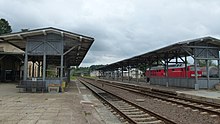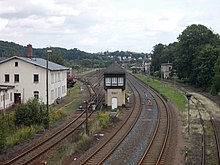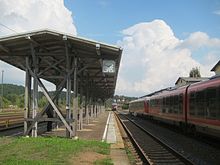Nossen train station
| Nossen | |
|---|---|
|
Entrance building, street side
|
|
| Data | |
| Operating point type | railway station |
| Location in the network |
Separation station former connection station |
| Platform tracks | 4th |
| abbreviation | DNO |
| IBNR | 8010258 |
| opening | October 25, 1868 |
| location | |
| City / municipality | Nossen |
| country | Saxony |
| Country | Germany |
| Coordinates | 51 ° 3 '39 " N , 13 ° 17' 35" E |
| Height ( SO ) | 219.49 m |
| Railway lines | |
|
|
| Railway stations and stops in Saxony | |
The Nossen station is an operating point of the railway line Borsdorf – Coswig and the railway lines beginning here to Riesa and to Moldava v Krušných horách in the municipality of the city of Nossen in Saxony. The station was also the end point of the former narrow-gauge railway from Freital-Potschappel . As the operating center of the so-called "Second Leipzig-Dresden Railway", the station today (2019) still has extensive track systems for passenger and freight traffic.
history
When the Nossen station was built in 1868, the tracks were kept quite simple. The first station building was designed as a one-story wooden structure. It was not until the opening of the Zellwaldbahn that the track system was extensively expanded and the reception building was replaced by a more representative structure in 1873. The station with the direct connection to Most thus had an international connection. The railway facilities were enlarged again by integrating the Riesa – Nossen railway line around 1880.
In 1886 the station building underwent various extensions. The station area was between the Freiberger Mulde and the road from Nossen to Döbeln and consisted of 9 main and 15 secondary tracks. This also included a track on which the rescue train stood and a slag track. Four platforms took up the extensive passenger traffic, with platform 1 for the Zellwaldbahn, platforms 2 and 3 for the second Leipzig-Dresden railway with crossings and platform 4 for the Riesa – Nossen railway line. The locomotive treatment systems were located northwest of the tracks on the road bridge to Döbeln. To the north of the track system there was a loading line for freight traffic. A goods shed and a head and side loading ramp were opened to the station building. When the Freital-Potschappel-Nossen narrow-gauge railway went into operation in 1899, its tracks were located south of the reception building on the station forecourt. The narrow-gauge systems consisted of a platform, engine shed, social building, reloading facilities with a loading crane and a reloading ramp for narrow-gauge vehicles to standard-gauge vehicles, as well as a trolley pit. The narrow-gauge tracks were laid out so that the two gauges did not cross, the standard-gauge tracks came from the east, the narrow-gauge tracks from the west to the transfer points. In terms of area, the Nossen station had reached its greatest extent.
In 1900 the regular-gauge track system was rebuilt with the installation of some switches and the extension of the through tracks. The road to Döbeln, which originally had a level crossing, was moved further west and led over the tracks with a bridge. The two signal boxes still in operation today (2019) date from 1894 (Stw 2) and 1907 (Stw 1). A siding to a paper mill was built. At that time the platform underpasses were built. The entire length of the entire station was about 200 meters. In the early 1920s, the officials' houses were built next to the train station. On the road to Rhäsa and Waldheim , housing estates for railway workers emerged, because around a third of the population worked directly or indirectly for the railway.
Statistical data from 1935 name 181,056 travelers who were transported by rail and who also came
for shipping from Nossen
- 12,536 t truckloads,
- 1,616 t freight,
- 1,133 tons of milk and
- 83 t express cargo.
Were received
- 50,358 t truckloads,
- 2,083 t freight,
- 127 t express goods and
- 86 tons of milk.
The service goods were dispatched from Nossen
- 3,946 t truckloads,
- 294 t freight and
- 60 t express goods.
Came to Nossen as service goods
- 15,065 t truckloads,
- 226 t of freight and
- 108 t express cargo.
After 1945 the track system was reduced by dismantling the second track on the Borsdorf – Coswig line. Further cuts in the station area occurred in 1972 when the Freital-Potschappel-Nossen narrow-gauge railway was shut down. After the end of the remaining operations at the Siebenlehn leather fiber works , the track systems were dismantled from 1974, but the high-rise buildings of the narrow-gauge railway were left standing. The track systems of the standard gauge were essentially preserved. On September 24, 1977 passenger train operations on the Zellwaldbahn were ended. In 1997, freight traffic on this route was discontinued. Since 1998 there has been no more passenger traffic on the Riesa – Nossen railway line . However, freight trains still run to the Rhäsa tank farm on this route. The Borsdorf – Coswig railway is the only line with regular traffic that touches the station.
Almost all standard gauge tracks north of the reception building up to platform 12 have been preserved. They are required to access the locomotive shed. Only the former station track of the Zellwaldbahn and its bypass are no longer passable today (2019). A bus stop has been set up on the station forecourt. The track to the paper mill and tracks 25 and 26 to the goods shed have been dismantled, the reception building is closed. The operation is carried out with classic interlocking technology and form signals . At the current status (2015), many high-rise buildings from the narrow-gauge era have been preserved.
Pictures of the narrow-gauge systems still in existence in 2015
Platforms
The island platform and the house platform are still there. Both have been connected by a tunnel since 1909.
traffic
In the beginning, operations on the Borsdorf – Coswig line developed rather moderately; There is no information about course books from the beginning. The traffic on the Zellwaldbahn was a bit stronger . There was a connection to Bohemia beyond Freiberg, which brought with it a brisk freight traffic.
- The timetable from 1874/1875 shows four pairs of trains on this route.
- Data on the Borsdorf – Coswig railway are available from 1876 ; Back then there were five trains a day in both directions.
- In 1899 the traffic on the Riesa – Nossen railway line was five pairs of trains a day, according to the timetable.
- In 1914 there were five pairs of trains on the entire section from Riesa to Freiberg, i.e. both lines together, according to the timetable.
- In 1918 the timetable lists four daily train pairs on the Riesa – Nossen railway line .
- In the summer schedule of 1927, four through trains were reported on the entire line from Riesa to Nossen , with connections in Lommatzsch in between.
- For the Borsdorf – Coswig railway line, there is no more information about the timetable until 1939; here thirteen trains ran through Nossen, although they did not run continuously on the line. In the same year, eight pairs of trains ran on the Zellwaldbahn .
- After 1945, the cancellation of train services on all three routes was enormous, the most affected was the Borsdorf – Coswig line due to the dismantling of the second track and the start of the Dresden – Leipzig ring train freight service on this route. Due to the closure of the Moldava border crossing, there was practically no more continuous freight traffic on the Zellwaldbahn .
From the railway Riesa-Nossen details are of course book in 1945, here perverted only two pairs of trains. In 1946 there were also two through trains in each direction, in 1947 there were three pairs of through trains.
The course book 1950/1951 shows five pairs of trains from the Zellwaldbahn .
- In 1965 there were five pairs of trains on the Zellwaldbahn that were issued in the timetable.
- In 1965, six pairs of trains ran daily on the Riesa – Nossen railway line .
- In 1967 the timetable for the Borsdorf – Coswig railway showed ten pairs of trains beginning, ending or passing through Nossen.
- In 1970 there were also ten pairs of trains on the same line, always with an express train that stopped in Nossen. In the last year of operation, six pairs of passenger trains ran on the Zellwaldbahn .
- In 1978 seven pairs of trains ran on the Riesa – Nossen railway line ,
- In 1989 there were also seven pairs of trains on this line.
- Until December 2015, regular passenger trains still ran on the Borsdorf – Coswig railway line , with Nossen station running every two hours.
Locomotive station / Nossen depot
Since the opening of Nossen station had a roundhouse scale Lokbehandlungsanlage with a 12 meter hub . The locomotive shed had twelve stands in 1915 and in the same year received a turntable with a diameter of 20 meters. The narrow-gauge systems had a separate locomotive shed with an inspection and slag pit and locomotive treatment systems. This locomotive shed had its own cistern with a capacity of 71 m³ and was able to supply the narrow-gauge locomotives with a slewing crane and standard-gauge locomotives with two other cranes.
When the Deutsche Reichsbahn-Gesellschaft was founded, the Nossen locomotive shed was converted into a railway depot and received facilities for independent repair of the locomotives. Among other things, there was an axle sink in Nossen . The roundhouse was enlarged to 14 stalls in 1941 with the allocation of new locomotives. In 1994 the Nossen depot was dissolved by Deutsche Bahn and continued as an independent department of the Riesa depot.
Local locomotives
In the course of time, the Nossen locomotive operation center had to provide extensive stringing services. At first it was the treatment center for locomotives in through traffic, later locomotives for the tensioning of trains were added by the branch lines.
Domestic standard gauge locomotives
Only around the time 1899/1900 can more precise stationing data be determined in the Bw Nossen. The locomotives of the Saxon VV series were stationed in Nossen. Passenger locomotives of the Sächsische IIIb and Saxon VIII V2 series were added for service on the branch lines. The XII H2 was particularly in use in passenger train service on the Zellwaldbahn and the Riesa – Nossen railway since 1910.
Prussian locomotives were used from the 1920s. For example, the depot was allocated P 8 series locomotives for passenger train service and G 8.1 and G 10 series freight locomotives . Class T 16 locomotives were used for the shunting service . With the outbreak of the Second World War , the first standard locomotives of the series 50 , 52 and 86 appeared .
After 1945, the XII H2 and the P 8 still dominated passenger train service, and the series 52 , 56.1 and 58 mainly in freight traffic . From 1961 new or Recolokomotives of the 23.10 series were used in passenger train service and the 50.35 series in freight train service. These locomotives were the last steam locomotives in the Nossen depot and ran until 1981.
With the introduction of diesel traction, locomotives of the V 60 and V 100 series were assigned to the depot . Locomotive drivers of the Bw Nossen drove on vehicles from other depots, such as locomotives of the 120 and 132 series , which, however, only ran on the Borsdorf – Coswig railway line .
After 1989 the employees of IG Dampflok Nossen e. V. gained attention with the renovation of historic locomotives. So the 99 715 in Nossen was made roadworthy again. The VT 4.12 was in Nossen for a long time. The most prominent vehicle in the locomotive shed is the 18 201 .
Domestic narrow-gauge locomotives
Since the opening of the Freital-Potschappel-Nossen narrow-gauge railway, a locomotive has always been stationed in Nossen, an IV K was here until 1931 , then a VI K until the mid-1950s .
Local cars and ancillary vehicles
On the standard gauge side, there were wagons for servicing the branch lines starting from Nossen. On the narrow-gauge railway, trolleys were stationed for the exchange of goods between narrow-gauge and standard-gauge.
Todays use
Today (2019) the IG Dampflok Nossen has its headquarters in the depot Nossen and stores its numerous exhibits there. Transport companies such as Wedler Franz Logistik GmbH & Co. KG maintain their vehicles here.
literature
- Ludger Kenning: Narrow-gauge railways around Mügeln and Wilsdruff . Kenning Verlag, Nordhorn 2000, ISBN 3-933613-29-9
- Collective of authors: The main line Borsdorf-Coswig , Wilsdruffer Bahnbücher
- Reiner Scheffler, Peter Wunderwald: The Riesa-Nossen railway line - a journey through time through the 125-year history of one of the most interesting railway lines in central Saxony ; Wilsdruffer Railway Books 2004
- Thorsten Adler, Karl-Heinz Böhm: The Zellwaldbahn ; IG steam locomotive Nossen e. V.
Web links
- Website about the Nossen train station on Sachsenschiene.net
- Website about the Borsdorf-Coswig railway at www.sachsenschiene.net
- Website on the Zellwaldbahn at www.sachsenschiene.net
- Website about the Riesa-Nossen railway line on sachsenschiene.net
- Website of the IG Dampflok Nossen e. V.
- Website about the company Wedler Franz Logistik
- Photos of the locomotives parked in the Nossen depot
- Film sequences about the railway festival in the Bw Nossen 2012 on youtube
- Photo collection from Bw Nossen in several epochs
- Tracks in service facilities (DNO) , DB Netz AG (PDF; track plan)
Individual evidence
- ^ Photograph of the Nossen train station on an undated photograph, on www.sachsenschiene.net
- ↑ a b Track plan of the Nossen station with the narrow-gauge layout on www.sachsenschiene.net
- ^ Ludger Kenning: Narrow gauge railways around Mügeln and Wilsdruff . Kenning Verlag, Nordhorn 2000, ISBN 3-933613-29-9 , pages 149 and 150
- ↑ Collective of authors: The main line Borsdorf – Coswig , Wilsdruffer Bahnbücher, page 107
- ↑ Station data on www.sachsenschiene.net
- ↑ Collective of authors: Die Hauptbahn Borsdorf-Coswig , Wilsdruffer Bahnbücher, page 110
- ↑ a b Track plan of Nossen station after the narrow-gauge railway was dismantled on www.sachsenschiene.net
- ^ Course book 1874/1875 Nossen Freiberg on www.sachsenschiene.net
- ↑ Collective of authors: Die Hauptbahn Borsdorf-Coswig , Wilsdruffer Bahnbücher, page 16
- ↑ Reiner Scheffler, Peter Wunderwald: The Riesa-Nossen railway line - a journey through time through the 125-year history of one of the most interesting railway lines in central Saxony ; Wilsdruffer Bahnbücher 2004, page 25
- ^ Course book 1914 Riesa-Moldava on www.sachsenschiene.net
- ↑ Reiner Scheffler, Peter Wunderwald: The Riesa-Nossen railway line - a journey through time through the 125-year history of one of the most interesting railway lines in central Saxony ; Wilsdruffer Railway Books 2004, page 32
- ↑ Reiner Scheffler, Peter Wunderwald: The Riesa-Nossen railway line - a journey through time through the 125-year history of one of the most interesting railway lines in central Saxony ; Wilsdruffer Bahnbücher 2004, page 34
- ↑ Collective of authors: Die Hauptbahn Borsdorf-Coswig , Wilsdruffer Bahnbücher, page 24
- ^ Course book 1939 Nossen-Freiberg on www.sachsenschiene.net
- ↑ Reiner Scheffler, Peter Wunderwald: The Riesa-Nossen railway line - a journey through time through the 125-year history of one of the most interesting railway lines in central Saxony ; Wilsdruffer Bahnbücher 2004, page 44
- ^ Course book 1950/51 Nossen-Freiberg on www.sachsenschiene.net
- ^ Course book 1965 Nossen-Freiberg on www.sachsenschiene.net
- ↑ a b c Reiner Scheffler, Peter Wunderwald: The Riesa-Nossen railway line - a journey through time through the 125-year history of one of the most interesting railway lines in central Saxony ; Wilsdruffer Bahnbücher 2004, page 54
- ↑ Collective of authors: Die Hauptbahn Borsdorf-Coswig , Wilsdruffer Bahnbücher, page 40
- ↑ Collective of authors: The main railway Borsdorf-Coswig , Wilsdruffer Bahnbücher, page 41
- ^ Course book 1977 Nossen-Freiberg on www.sachsenschiene.net
- ↑ Collective of authors: The main railway Borsdorf-Coswig , Wilsdruffer Bahnbücher, page 109
- ↑ Website about the museum vehicles parked in Nossen












